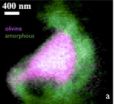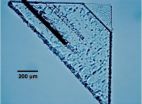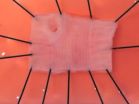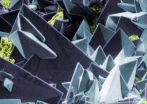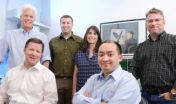(Press-News.org) The first analysis of space dust collected by a special collector onboard NASA's Stardust mission and sent back to Earth for study in 2006 suggests the tiny specks, which likely originated from beyond our solar system, are more complex in composition and structure than previously imagined.
The analysis, completed at a number of facilities including the U.S. Department of Energy's Lawrence Berkeley National Lab (Berkeley Lab) opens a door to studying the origins of the solar system and possibly the origin of life itself.
"Fundamentally, the solar system and everything in it was ultimately derived from a cloud of interstellar gas and dust," says Andrew Westphal, physicist at the University of California, Berkeley's Space Sciences Laboratory and lead author on the paper published this week in Science. "We're looking at material that's very similar to what made our solar system."
Westphal, who is also affiliated with Berkeley Lab's Advanced Light Source, a DOE Office of Science User Facility where some of the research was conducted, and his 61 co-authors found and analyzed a total of seven grains of possible interstellar dust and presented preliminary findings.
All analysis was non-destructive, meaning that it preserved the structural and chemical properties of the particles. While the samples are suspected to be from beyond the solar system, he says, potential confirmation of their origin must come from subsequent tests that will ultimately destroy some of the particles.
"Despite all the work we've done, we have limited the analyses on purpose," Westphal explains. "These particles are so precious. We have to think very carefully about what we do with each particle."
Between 2000 and 2002, the Stardust spacecraft, on its way to meet a comet named Wild 2, exposed the special collector to the stream of dust coming from outside our solar system. The mission objectives were to catch particles from both the comet coma as well as from the interstellar dust stream. When both collections were complete, Stardust launched its sample capsule back to earth where it landed in northwestern Utah. The analyses of Stardust's cometary sample have been widely published in recent years, and the comet portion of the mission has been considered a success.
This new analysis is the first time researchers have looked at the microscopic particles collected en route to the comet. Both types of dust were captured by the spacecraft's sample-collection trays, made of an airy material called aerogel separated by aluminum foil. Three of the space-dust particles (a tenth the size of comet dust) either lodged or vaporized within the aerogel while four others produced pits in the aluminum foil leaving a rim residue that fit the profile of interstellar dust.
Much of the new study relied on novel methods and techniques developed specifically for handling and analyzing the fine grains of dust, which are more than a thousand times smaller than a grain of sand. These methods are described in twelve other papers available now and next week in the journal of Meteoritics & Planetary Science.
One of the first research objectives was to simply find the particles within the aerogel. The aerogel panels were essentially photographed in tiny slices by changing the focus of the camera to different depths, which resulted in millions of images eventually stitched together into video. With the help of a distributed science project called Stardust@home, volunteer space enthusiasts from around the world combed through the video, flagging tracks they believed were created by interstellar dust. More than 100 tracks have been found so far, but not all of these have been analyzed. Additionally only 77 of the 132 aerogel panels have been scanned. Still, Westphal doesn't expect more than a dozen particles of interstellar dust will be seen.
The analysis tapped a variety of microscopy techniques including those that rely on synchrotron radiation from the Advanced Light Source (ALS) at Berkeley Lab. The ALS is particularly well suited to this kind of analysis, says Hans Bechtel, principal scientific engineering associate at Berkeley Lab. "Synchrotrons are extremely bright light sources that enable light to be focused down to the small size of these particles while providing unprecedented chemical identification," he says.
Researchers used the scanning transmission x-ray and Fourier transform infrared microscopes at the ALS. The x-ray microscope ruled out tens of interstellar dust candidates because they contained aluminum, not found in space or other substances and possibly knocked off the spacecraft and embedded in the aerogel. The infrared spectroscopy helped to identify sample contamination that could ultimately be subtracted later.
"Almost everything we've known about interstellar dust has previously come from astronomical observations—either ground-based or space-based telescopes," says Westphal. But telescopes don't tell you about the diversity or complexity of interstellar dust, he says. "The analysis of these particles captured by Stardust is our first glimpse into the complexity of interstellar dust, and the surprise is that each of the particles are quite different from each other."
The researchers found that the two larger dust particles from the aerogel have a fluffy composition, similar to that of a snowflake, says Westphal. Models of interstellar dust particles had suggested a single, dense particle, so the lighter structure was unexpected. They also contain crystalline material called olivine, a mineral made of magnesium, iron, and silicon, which suggest the particles came from disks or outflows from other stars and were modified in the interstellar medium.
Three of the particles found in the aluminum foil were also complex, and contain sulfur compounds, which some astronomers believe should not occur in interstellar dust particles. Study of further foil-embedded particles could help explain the discrepancy.
Westphal says that team will continue to look for more tracks as well as take the next steps in dust analysis. "The highest priority is to measure relative abundance of three stable isotopes of oxygen," he says. The isotope analysis could help confirm that the dust originated outside the solar system, but it's a process that would destroy the precious samples. In the meantime, Westphal says, the team is honing their isotope analysis technique on artificial dust particles called analogs. "We have to be super careful," he says. "We're doing a lot of work on analogs to practice, practice, practice."
INFORMATION:
This research was supported by NASA, the Klau8s Tschira Foundation, the Tawani Foundation, the German Science Foundation, and the Funds for Scientific Research, Flanders, Belgium. In addition to ALS, the research made use of the National Synchrotron Light Source at Brookhaven National Laboratory and the Advanced Photon Source at Argonne National Laboratory, both also DOE Office of Science User Facilities.
Lawrence Berkeley National Laboratory addresses the world's most urgent scientific challenges by advancing sustainable energy, protecting human health, creating new materials, and revealing the origin and fate of the universe. Founded in 1931, Berkeley Lab's scientific expertise has been recognized with 13 Nobel prizes. The University of California manages Berkeley Lab for the U.S. Department of Energy's Office of Science. For more, visit http://www.lbl.gov.
The DOE Office of Science is the single largest supporter of basic research in the physical sciences in the United States and is working to address some of the most pressing challenges of our time. For more information, please visit science.energy.gov.
Mysteries of space dust revealed
Berkeley Lab researchers help give a first look at suspected extra-solar particles
2014-08-14
ELSE PRESS RELEASES FROM THIS DATE:
New Milky Way maps help solve stubborn interstellar material mystery
2014-08-14
An international team of sky scholars, including a key researcher from Johns Hopkins, has produced new maps of the material located between the stars in the Milky Way. The results should move astronomers closer to cracking a stardust puzzle that has vexed them for nearly a century.
The maps and an accompanying journal article appear in the Aug. 15 issue of the journal Science. The researchers say their work demonstrates a new way of uncovering the location and eventually the composition of the interstellar medium—the material found in the vast expanse between star systems ...
CF mucus defect present at birth
2014-08-14
VIDEO:
This is a 3-D reconstruction from time-lapse CT-scans of a CF pig lung. Images show the trachea and bronchi. Colored round dots represent positions of particles that were...
Click here for more information.
Mucus is key to keeping our lungs clean and clear of bacteria, viruses, and other foreign particles that can cause infection and inflammation. When we inhale microbes and dust, they are trapped in the mucus and then swept up and out of the lungs via a process called ...
Potential drug therapy for kidney stones identified in mouse study
2014-08-14
Anyone who has suffered from kidney stones is keenly aware of the lack of drugs to treat the condition, which often causes excruciating pain.
A new mouse study, however, suggests that a class of drugs approved to treat leukemia and epilepsy also may be effective against kidney stones, researchers at Washington University School of Medicine in St. Louis report.
The drugs are histone deacetylase inhibitors, or HDAC inhibitors for short. The researchers found that two of them — Vorinostat and trichostatin A — lower levels of calcium and magnesium in the urine. Both calcium ...
Broader organ sharing won't harm liver transplant recipients
2014-08-14
New research shows that broader sharing of deceased donor livers will not significantly increase cold ischemia time (CIT)—the time the liver is in a cooled state outside the donor suggesting that this is not a barrier to broader sharing of organs. However, findings published in Liver Transplantation, a journal of the American Association for the Study of Liver Diseases and the International Liver Transplantation Society, do indicate that broader sharing of organs will significantly increase the percentage of donor organs that are transported by flying rather than driving. ...
Scientists study 'talking' turtles in Brazilian Amazon
2014-08-14
AUDIO:
These are vocalizations made between adults and hatchlings (individual sounds repeated for the listener's benefit).
Click here for more information.
Turtles are well known for their longevity and protective shells, but it turns out these reptiles use sound to stick together and care for young, according to the Wildlife Conservation Society and other organizations.
Scientists working in the Brazilian Amazon have found that Giant South American river turtles actually ...
Scientists fold RNA origami from a single strand
2014-08-14
RNA origami is a new method for organizing molecules on the nanoscale. Using just a single strand of RNA, many complicated shapes can be fabricated by this technique. Unlike existing methods for folding DNA molecules, RNA origamis are produced by enzymes and they simultaneously fold into pre-designed shapes. These features may allow designer RNA structures to be grown within living cells and used to organize cellular enzymes into biochemical factories. The method, which was developed by researchers from Aarhus University (Denmark) and California Institute of Technology ...
New analysis links tree height to climate
2014-08-14
MADISON, Wis. — What limits the height of trees? Is it the fraction of their photosynthetic energy they devote to productive new leaves? Or is it their ability to hoist water hundreds of feet into the air, supplying the green, solar-powered sugar factories in those leaves?
Both factors — resource allocation and hydraulic limitation — might play a role, and a scientific debate has arisen as to which factor (or what combination) actually sets maximum tree height, and how their relative importance varies in different parts of the world.
In research to be published in ...
New gene editing method shows promising results for correcting muscular dystrophy
2014-08-14
DALLAS – August 14, 2014 – UT Southwestern Medical Center researchers successfully used a new gene editing method to correct the mutation that leads to Duchenne muscular dystrophy (DMD) in a mouse model of the condition.
Researchers used a technique called CRISPR/Cas9-mediated genome editing, which can precisely remove a mutation in DNA, allowing the body's DNA repair mechanisms to replace it with a normal copy of the gene. The benefit of this over other gene therapy techniques is that it can permanently correct the "defect" in a gene rather than just transiently adding ...
9/11 dust cloud may have caused widespread pregnancy issues
2014-08-14
Pregnant women living near the World Trade Center during 9/11 experienced higher-than-normal negative birth outcomes, according to a new working paper by Princeton University's Woodrow Wilson School of Public and International Affairs.
These mothers were more likely to give birth prematurely and deliver babies with low birth weights. Their babies - especially baby boys - were also more likely to be admitted to neonatal intensive care units after birth. The study, led by the Wilson School's Janet Currie and Hannes Schwandt, was released by the National Bureau of Labor ...
Reduced testosterone tied to endocrine-disrupting chemical exposure
2014-08-14
Washington, DC—Men, women and children exposed to high levels of phthalates - endocrine-disrupting chemicals found in plastics and some personal care products – tended to have reduced levels of testosterone in their blood compared to those with lower chemical exposure, according to a new study published in the Endocrine Society's Journal of Clinical Endocrinology & Metabolism (JCEM).
Testosterone is the main sex hormone in men. It contributes to a variety of functions in both sexes, including physical growth and strength, brain function, bone density and cardiovascular ...
LAST 30 PRESS RELEASES:
University of Oklahoma researcher awarded funding to pursue AI-powered material design
Exploring how the visual system recovers following injury
Support for parents with infants at pediatric check-ups leads to better reading and math skills in elementary school
Kids’ behavioral health is a growing share of family health costs
Day & night: Cancer disrupts the brain’s natural rhythm
COVID-19 vaccination significantly reduces risk to pregnant women and baby
The role of vaccination in maternal and perinatal outcomes associated with COVID-19 in pregnancy
Mayo Clinic smartwatch system helps parents shorten and defuse children's severe tantrums early
Behavioral health spending spikes to 40% of all children’s health expenditures, nearly doubling in a decade
Digital cognitive behavioral treatment for generalized anxiety disorder
Expenditures for pediatric behavioral health care over time and estimated family financial burden
Air conditioning in nursing homes and mortality during extreme heat
The Alps to lose a record number of glaciers in the next decade
What makes a good proton conductor?
New science reporting guide published for journalists in Bulgaria
New international study reveals major survival gaps among children with cancer
New science reporting guide published for journalists in Turkey
Scientists develop a smarter mRNA therapy that knows which cells to target
Neuroanatomy-informed brain–machine hybrid intelligence for robust acoustic target detection
Eight SwRI hydrogen projects funded by ENERGYWERX
The Lundquist Institute and its start-up company Vitalex Biosciences Announces Strategic Advancement of Second-Generation fungal Vaccine VXV-01 through Phase 1 Trials under $40 Million Competitive Con
Fine particles in pollution are associated with early signs of autoimmune disease
Review article | Towards a Global Ground-Based Earth Observatory (GGBEO): Leveraging existing systems and networks
Penn and UMich create world’s smallest programmable, autonomous robots
Cleveland researchers launch first major study to address ‘hidden performance killer’ in athletes
To connect across politics, try saying what you oppose
Modulating key interaction prevents virus from entering cells
Project explores barriers to NHS career progression facing international medical graduates
Jeonbuk National University researchers explore the impact of different seasonings on the flavor perception of Doenjang soup
Two Keck Medicine of USC Hospitals named Leapfrog Top Teaching Hospitals
[Press-News.org] Mysteries of space dust revealedBerkeley Lab researchers help give a first look at suspected extra-solar particles
